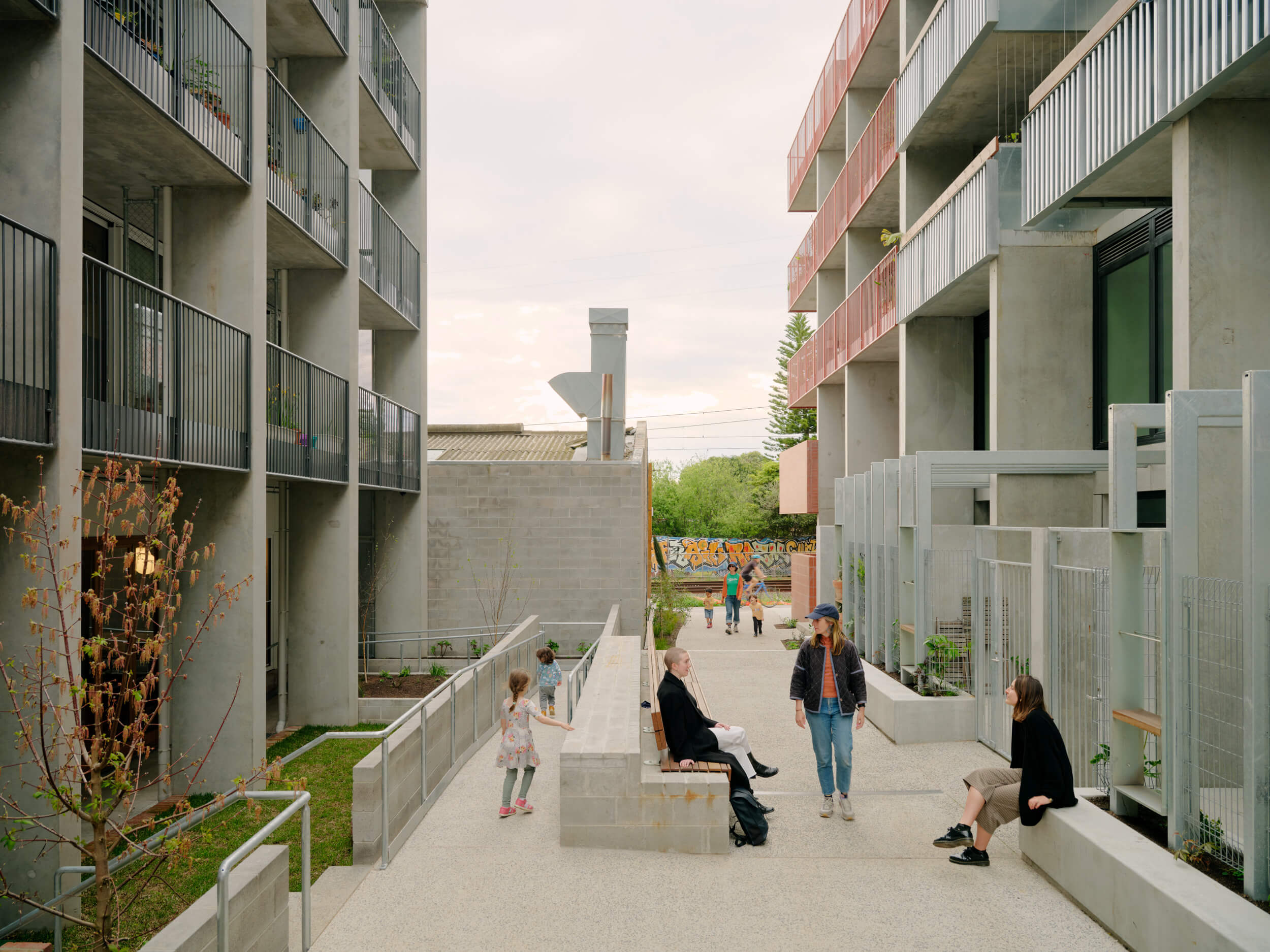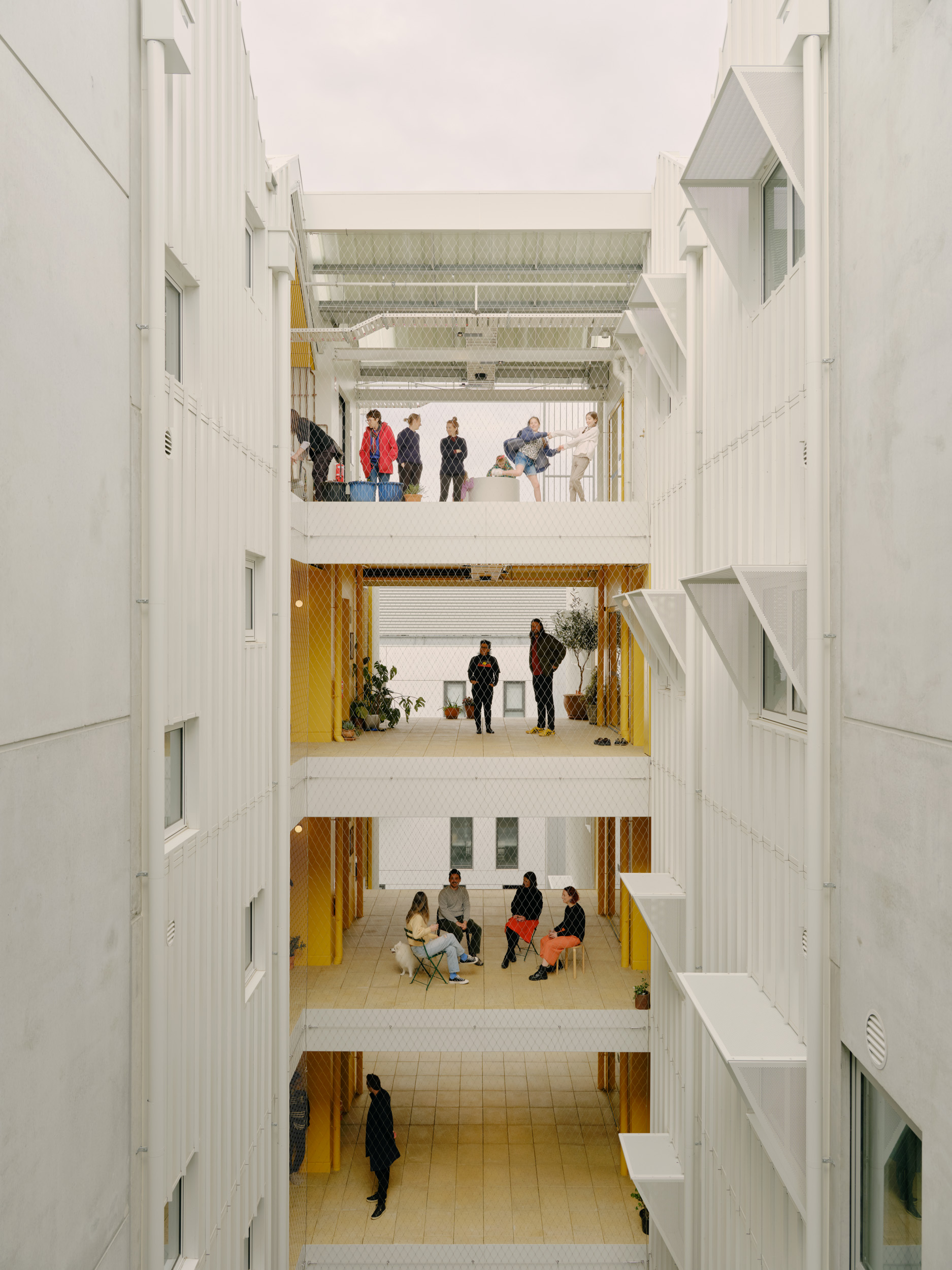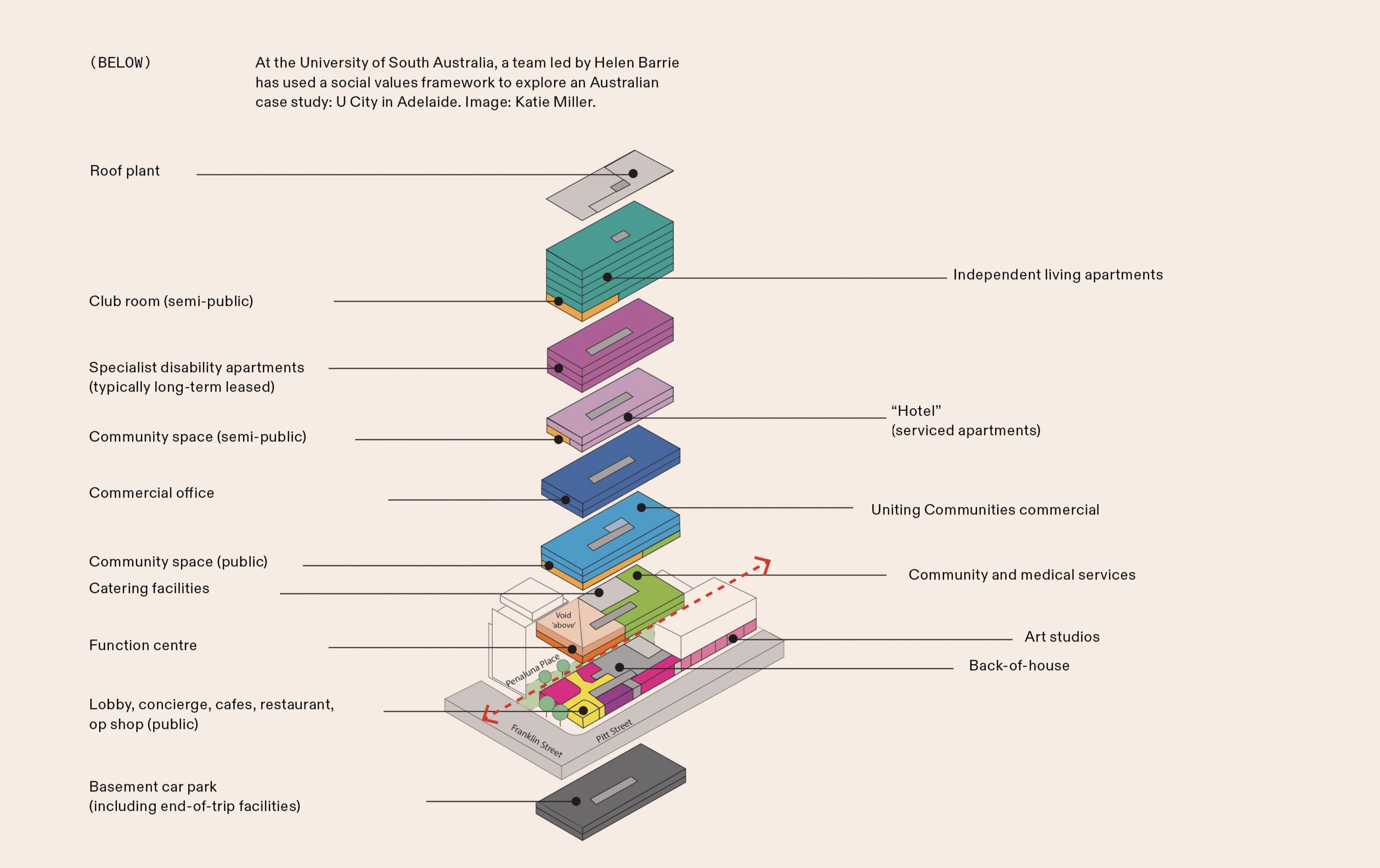Nightingale Village
Review by Alexis Kalagas

Writing 25 years ago about John Portman in an essay on the fragmented “disurbanism” of Atlanta, Rem Koolhaas argued that Portman’s synthesis of the roles of architect and developer – “a self-administered Faustian bargain” – had eliminated necessary creative tension. In Portman’s megastructural projects, “the vision of the architect [was] realised without opposition, without influence, without inhibition.”1 The architect-as-developer model has a long, chequered history. For every Solidspace (London) or architect-led Baugruppen (Berlin) capitalizing on the freedom to experiment outside prevailing real-estate-market logics, there are countless speculative, small-scale homebuilders looking to simply capitalize, through nondescript exercises in entrepreneurial city-making. Portman himself framed his hybrid career as an enlarging of architectural agency, elevating the importance of design within the development equation and enabling him to “design the city … not just the individual buildings.”2,3
This sentiment comes to mind when appraising Nightingale Village – simultaneously the final, defining statement of Nightingale’s original architect-as-developer incarnation, and the first expression of its environmental and community-led ethos to project beyond the individual building. Acquired in 2017 as a cluster of low-slung warehouses in the same former light-industrial pocket of Brunswick as Nightingale 1 (Breathe, 2017),4 the site is now home to six buildings designed and developed by six different architects, spread across two blocks hugging the Upfield train line and shared (bike/pedestrian) path. An additional building, by Wowowa Architecture, was a casualty of the City of Merri-bek’s late-dawning realization that unrelenting boundary-to-boundary development in the area was depriving the burgeoning resident community of access to vital open space. In 2019, in what was a first for the council, it purchased the seventh Village site and adjacent properties to create a new public park.
Wowowa’s loss was Evergreen’s (Clare Cousins Architects) and Parklife’s (Austin Maynard Architects) gain. The last parcel allocated, Parklife became the most conventionally appealing, with a sheer northerly aspect to Bulleke-bek Park and separation from the train line. Austin Maynard Architects was able to learn from its Terrace House (2022), which began as a contemporaneous Nightingale project. According to director Mark Austin, the key lesson could be distilled to a simple mantra: “efficiency, efficiency, efficiency.” Principal Andrew Maynard describes a broader desire to create a “village inside a village” at Parklife. Both impulses are evident in the design, which replicates the tongue-in-cheek playfulness that has become a hallmark of the practice, while focusing limited resources on maximizing collective amenity. Most striking is an arcade-like passage connecting the park to the Village hub of Duckett Street – a civic gesture consistent with a wider approach to urban design that Openwork director Mark Jacques has characterized as an erosion of the autonomy of the allotment boundary.5
Though strange bedfellows stylistically, with Parklife’s jaunty balconies and gabled roofline abutting Evergreen’s rational lines and bottom-heavy brutalism, this idea of ambiguous territory is formalized in a symbiotic relationship between the two buildings via reciprocal light wells. The train side of Evergreen’s open stair is glazed, enabling both resident communities to benefit from long views and western light that penetrates deep into the plan, while enjoying protection from the wind. As Clare Cousins Architects’ first multiresidential project, Evergreen was a “baptism of fire,” according to director Clare Cousins. Having run feasibilities on multiple sites before the Village was acquired, Cousins was attracted to the smaller footprint (at 27 apartments, Evergreen is the most intimate building in the precinct) and defined edge, which is foregrounded through the location of the entry loggia adjacent to the thrum of the shared path.
Both Evergreen and Leftfield (Kennedy Nolan) have been compelled to reckon with their proximity to the train line, requiring heavy buffering at lower levels in case of a derailment. Kennedy Nolan co-principal Patrick Kennedy suggests that this “muscular infrastructure” – in each case, expressed as a sequence of massively oversized columns – lends a “Piranesian scale” to Leftfield’s arrival experience, bolstering a wider ambition to achieve a powerful urban presence. Co-principal Rachel Nolan describes the western elevation’s colour and cut-outs as possessing “real chutzpah,” establishing a visual marker that is echoed in the geometric supergraphics applied within the building’s domestic interiors. As you round the corner into Duckett Street, though, most immediately perceptible is the aggregate effect of a car-free philosophy applied at scale. Closed to traffic, the ground plane is spared a deadening mix of ramps and services – tonic to a unified public realm that hints at a public life to come.



Bounded on all sides by Village neighbours, CRT+YRD (Hayball) has a more introverted character, ceding commercial frontage to a lone outpost of Duckett-facing ground-level residential (the “door-man’s house” was purchased by a studio member). At first glance, CRT+YRD’s internalized scheme might imply a reticence to embrace the wider project’s sense of collective possibility. But Hayball’s willingness to part with a piece of its site to ensure Leftfield was developable reflects a deeper level of coordination, manifest most literally in a common bike store and share-car park that runs below Urban Coup (Archi-tecture Architecture with Breathe), Leftfield, CRT+YRD and Skye House (Breathe). Hayball principal Bianca Hung explains that the central open-air courtyard enables “a sense of layering through the home . . . that is quite unique to our building.” Reminiscent of Nightingale 2 (Six Degrees, 2019), subtle articulation invites occupation of the shared access galleries while establishing a threshold to each dwelling, imbuing the larger apartment plans with a flexibility in program.
Perhaps the most imitated feature of Nightingale 1 is its rooftop garden, albeit reproduced without the laundry facilities that transformed it from sales tool to site of everyday neighbourly encounter. According to Madeline Sewall, director of houses at Breathe, a challenge at Skye House was “to make [the] rooftop work even harder across all seasons.” The response is a flexible, patio-like space that can be sealed off in colder months as a winter garden. Like nearby Nightingale Anstey (Breathe, 2022), the rooftop at Skye House also includes a surprisingly modest and utilitarian “bathhouse.” An important shared amenity for residents – especially families – forgoing access to private baths for reasons of cost and “inherited accessibility” (a shower-over-bath arrangement could represent a mobility challenge to future residents), the bathhouse also reflects the difference between the informed speculation of the Village versus truly deliberative projects. Briefs were adapted to preferences revealed via the Nightingale database and a building-by-building balloting process that functioned as a feedback loop, but the inherent limitations of off-plan development prevented future residents from actively negotiating meaningful individual trade-offs in favour of forms of communal luxury.
The one exception to this paradigm at the Village is Urban Coup, a raw but welcoming cohousing project that differs from the other buildings because the resident community existed prior to the purchase of the site, so no ballot occurred. Architecture Architecture design director Nick James notes that “to a certain extent, the architectural language of the building was less important than delivering a series of shared spaces and the ability for future amenity.” Urban Coup residents were heavily involved with the design, collaborating with the architects via a series of codesign workshops. The “heart and soul” of Urban Coup is a large communal kitchen and dining room that one imagines will, in the future, spill out into the semi-public mews created through the coordinated ground-floor setbacks of Urban Coup, Leftfield, CRT+YRD and Skye House.
This kitchen/dining room was also the only fully realized communal space at the time of writing. A guesthouse, multipurpose room, basement workshop and music room have all been provided as cold shells, with future fitouts designed but not delivered as part of the base build because of cost pressures. James reiterates that “once you’ve built the building, you can’t build those spaces,” which necessitates an approach that creatively anticipates the long life of the building and “how the cohousing community can allow those spaces to evolve.” There is something liberating in this acceptance of the unfinished that is suggestive of both the incremental development found throughout the Global South (and memorably embedded as a design strategy in Elemental’s “half a house” typology at Quinta Monroy in Chile) and the more familiar delayed gratification of alterations and additions to single family homes, subject to the drip-feed of savings replenished over time.
Urban Coup is notable too for its diversity in apartment types, reflecting a level of customization precluded elsewhere in the Village by the limitations of off-plan sales. Overall, the Village floorplans are surprisingly conventional, given the potential for experimentation in an architect-led project of this scale – although constrained by the narrow and deep infill parcels and deference to Nightingale Housing in shaping the apartment mix and price ceilings. The result is a focus on one- and two-bedroom dwellings and “Teilhaus” micro-apartments – an Existenzminimum product pitched as an affordable entry point into homeownership. Though admirable in redressing the lack of quality stock meeting the needs of Melbourne’s expanding pool of smaller households, with only 8 percent of apartments offering three or four bedrooms, the Village has effectively designed out the ability to accommodate a true cross-section of society (the titular village) and left Australia’s cultural aversion to higher density urban living for families and extended shared households unchallenged.
Purchaser ballots for the Village buildings (other than Urban Coup) were held in late 2018 and 2019. Around the same time, Nightingale Housing began its transition away from an “open source” licensing strategy toward an in-house development model, with architects engaged at arms-length instead of taking on development risk. Notwithstanding the merits of this shift, its fact marks out the Village as a one-off. Indeed, replicating the project using the same architect-as-developer model would not be financially viable given the readiness of the practices involved to effectively donate time that would usually be remuner-ated in a fee-for-service role. According to Maynard, “You look at the quality and the cost . . . there’s thousands of hours of donated time subsidizing that difference.” Cousins concurs: “A huge amount of sweat equity and pro bono hours have gone into delivering [the] project . . . I think the model did need to change.”
Given that change has now occurred, how should we assess the Village? For Nightingale Housing, it has been catalytic, enabling the organization to scale by attracting institutional capital. Indeed, future multi-architect projects are already underway. When asked what he would like to see at the Village in five years’ time, CEO Dan McKenna’s response was immediate: “A really healthy, thriving community . . . there’s so much connection within and across those buildings already.” In part, this early sense of life bleeding between buildings reflects the self-selecting nature of the Nightingale resident community, but it is also a product of the Village’s combination of distinct building-scale identities and collective precinct-scale planning. If we accept Portman’s assertion that increased agency for the architect-as-developer is found in “designing the city,” then it is the latter that may prove to be the Village’s ultimate legacy. While less eye-catching than an assemblage of stylistic signatures, in time the ambiguous approach to boundaries and sense of responsibility to a wider public could suggest new approaches to neighbourhood-scale development.
Notes
1 Rem Koolhaas and Bruce Mau, S, M, L, XL (New York: Monacelli Press,1995), 841.
2 The writer is currently employed by a property developer working across mixed-use and residential projects. He has a longstanding interest in housing innovation and the opinions shared here are entirely his own.
3 John Portman and Jonathan Barnett, The Architect as Developer (McGraw-Hill, 1976), 136.
4 For a discussion of Nightingale Housing, see Jacqui Alexander, “Nightingale Housing five years on,” 4 March 2021, available at architectureau.com/articles/nightingale-housing-five-years-on.
5 See Jen Lynch, “Expanding the residential agenda #4: Mark Jaques,” Landscape Australia, 1 February 2021, available at landscapeaustralia.com/articles/expanding-the-residential-agenda-mark-jacques.
Nightingale Village Executive architect Hayball; Project team Luc Baldi, Robert Mosca, Yuyuen Low, Saifee Akil, Ela Rajapackiyam; Builder Hacer; Project manager Fontic; Urban planner Hansen Partnerships; Quantity surveyor WT Partnerships; Engineer WSP; Building surveyor Steve Watson and Partners; Access consultant Access Studio; Acoustic engineer Arup; Wayfinding Olax; Arborist Tree Logic; Traffic GTA Consultants; Waste management Leigh Design
Urban Coup Architect Breathe with Architecture Architecture; Project team Nick James, Michael Roper, Daria Selleck (Architecture Architecture), Ali Galbraith, Bettina Robinson, Bonnie Herring, Emily McBain, Fairley Batch, Giles Freeman, Marie Penny, Mark Ng, Patricia Bozyk, Renée Eleni Agudelo, Sarah Mealy, Shannon Furness (Breathe); Landscape architect Openwork; ESD WSP
Leftfield Architect Kennedy Nolan; Project team Patrick Kennedy, Rachel Nolan, Michael Macleod, Victoria Reeves, Elizabeth Campbell; Landscape architect Amanda Oliver Gardens, Openwork; ESD Umow Lai
CRT+YRD Architect Hayball; Project team Luc Baldi, Rob Stent, Bianca Hung, James Luxton, Gianni Iacobaccio, Oliver Monk; Landscape architect Openwork; ESD Umow Lai
Skye House Architect Breathe; Project team Jeremy McLeod, Tamara Veltre, Madeline Sewall, Frances McLennan, Bettina Robinson, Fairley Batch, Bonnie Herring; Landscape architect Openwork; ESD Umow Lai
Evergreen Architect Clare Cousins Architects; Project team Clare Cousins, Oliver Duff, Tara Ward, Candice Chan; Landscape architect Eckersley Garden Architecture, Openwork; ESD WSP
Parklife Architect Austin Maynard Architects; Project team Mark Austin, Andrew Maynard, Mark Stranan; Landscape architect Openwork; ESD WSP
Alexis Kalagas is head of public programs at Molonglo.

Published online:
06 Mar 2023
Source:
Architecture Australia
Designing the city for today and tomorrow:
The expanding role, value and agency of architects
Mar / Apr
2023



